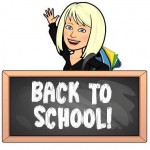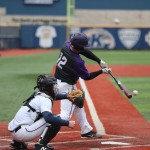![]() When I reflect on my first year of teaching, I often joke that I wish I could go back to those students and apologize to them. Looking back, I didn’t know what I was doing. I probably used many instructional methods that weren’t best practice. Most days seemed challenging as my patience often waned. However, I knew I would eventually improve if I kept at it and continued to learn. I reflected after each day and surrounded myself with quality, experienced teachers. Little by little, I gained experience, made connections with students, and improved my practice.
When I reflect on my first year of teaching, I often joke that I wish I could go back to those students and apologize to them. Looking back, I didn’t know what I was doing. I probably used many instructional methods that weren’t best practice. Most days seemed challenging as my patience often waned. However, I knew I would eventually improve if I kept at it and continued to learn. I reflected after each day and surrounded myself with quality, experienced teachers. Little by little, I gained experience, made connections with students, and improved my practice.
Fast forward ten years to the situation we are in now, teaching during COVID-19. I am currently teaching synchronous physical education virtually, eventually moving to an in-person, social distance PE class. Obviously, I have never taught either of these environments. Much of the strategies and routines I have used previously won’t apply in these settings. Teachers are forced to teach in ways in which they aren’t familiar. Whether you have been teaching for two years or thirty years, with distance learning and/or in-person social distance this year, we will all feel like first-year teachers again. With our students in mind, we should accept this reality, embrace the challenge, and stay the course.
There are many challenges in our current situation. Let’s start with a challenge of mine, and probably for many teachers, especially those at the elementary level. What I have been praising and expecting students to do will now change. For example, I have always praised high fives, hugs, helping others off the ground, putting an arm around a sad classmate, etc. Before COVID-19, my students were meeting those expectations. My fear is now students will be confused. Much of my praise and training will be all for not, at least in the short term. I can’t imagine saying something like, “Please stay away from your friends” or “please don’t share your equipment.” Students will be hearing mixed messages. Now, we need to explore new ways to show kindness and gratitude.
There are also positives of teaching in our current situation, whether it’s virtual or in-person social distance. Of course, we could complain about all the negatives and forget about the positives, but that wouldn’t help anyone. With virtual learning nowadays, there are a lot of helpful, free resources and apps available that maximize student learning, engagement, and interaction between students and teachers like “Flipgrid”, “Nearpod”, “EdPuzzle”, and “Pear Deck,” to name a few. Having used none of them before this year, I have had to get out of my comfort zone and surround myself with people who are familiar with them that can help me. In essence, this pandemic is pushing some teachers, including myself, beyond their comfort zone to learn new strategies that they might not otherwise have learned. Let’s also consider that we can still actually see all of our students using interactive platforms like “Zoom” or “Microsoft Teams.” This is important because it helps establish a positive, safe classroom climate. Because we can see each other, it feels a bit more “normal.” If this pandemic happened thirty years ago, who knows what teachers would have done. I can still praise students’ effort, eye contact, listening ears, being prepared, etc. Even though this might feel uncomfortable or different, by accepting it and staying positive, we can make the most out of the situation, which will ultimately benefit our students.
I just completed week one of teaching virtually. The first few classes were challenging, to say the least. It seemed new issues arose in each class (videos of students not working, students not able to access the “chat”, students not able to connect to our class with various devices, etc.). I tried to stay calm, while also taking notes on issues that I intended to fix for next time. I even laughed with my students and frequently told them, “I have no clue, but I’ll figure it out!” My goal was to model for students that we aren’t always going to immediately know everything. We are humans; we are going to make mistakes. Some things are out of our control. We should continue doing our best, and eventually, things will get better.
By the end of the week, we had fixed most of the problems. Students and I started making connections. A special moment happened in a 3rd-grade c lass. I had each student run to grab something meaningful and special to them to share with the class. Most students brought back a toy, video game, or stuffed animal. However, one student brought back his older sister. He said, “This is my sister, Lilly. She means a lot to me. She helps me, and she is there for me,” while he hugged her as other students watched. I started to tear up. I praised him for following his heart, as some students might be afraid to admit something like this in front of their peers. As a class, we connected that gesture to one of our “Essential Agreements”, which is “Grateful.” Right then and there, I knew our class would be fine. We may not achieve or master everything we would in a “normal” PE setting, but we can still accomplish a significant amount by making content relevant and meaningful for our students.
lass. I had each student run to grab something meaningful and special to them to share with the class. Most students brought back a toy, video game, or stuffed animal. However, one student brought back his older sister. He said, “This is my sister, Lilly. She means a lot to me. She helps me, and she is there for me,” while he hugged her as other students watched. I started to tear up. I praised him for following his heart, as some students might be afraid to admit something like this in front of their peers. As a class, we connected that gesture to one of our “Essential Agreements”, which is “Grateful.” Right then and there, I knew our class would be fine. We may not achieve or master everything we would in a “normal” PE setting, but we can still accomplish a significant amount by making content relevant and meaningful for our students.
This year, we all feel like first-year teachers again. We need to accept the fact that our teaching situation has changed. With our students in mind, let’s make the most of the hand we were dealt. In our PE classes, we discuss the students’ “What, Why, How” for each lesson. What are students learning, why are they learning it, and how do they know if they have learned it? As teachers, we also have a “What, Why, How” relative to our teaching practice and philosophy. Our ‘What’ and ‘How’ may have changed this year, but our ‘Why’ has stayed the same. Most teachers enter the profession to make a difference and inspire children. That will continue to be true, regardless of what school or environment in which we teach. It just might look a little different this year.







